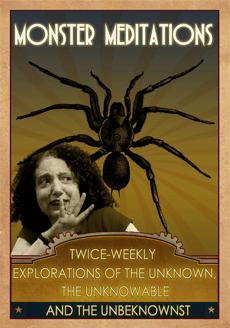Choose your MONSTER! Are you fond of charming, ever-young vampires? Do you have a yen for rough & ready werewolves? Have you fantasized cobbling together a perfect monster — like Dr. Frankenstein? Or do you picture yourself leading a battalion of zombies?
There are all sorts of Monsters that appeal to all sorts of tastes. Although I’m usually inclined to write about vampires — and I recently wrote my first werewolf short story — I’ve been playing around with an idea that strays into the territory of mythological beasts — another brand of monsters entirely.
Maybe it’s simply the fabulous “zoo” of mythological creatures at the Metropolitan Museum of Art? But I’ve been wondering about the Sphinx, the Dragon, and the Chimera — three beasts that cross cultural boundaries and turn up in different mythologies.
The Sphinx appears in Egypt, Asia and all over the ancient world. In classical Greek mythology the Sphinx is most famous for her riddle.
“What goes on four legs at dawn, two legs at noon, and three legs in the evening?”
Oedipus, yes THAT Oedipus, was the clever man who finally solved the riddle. He said the answer was “man” — a creature that crawls on four legs as a baby, walks on two in the middle of life and uses a cane to walk in old age, making him three-legged.
In most versions of the myth, the Sphinx is so distraught when he gives the right answer that she immediately kills herself.
The appearance of the Sphinx varies from place to place — wings appear in Asia, sometimes she has human hair and sometimes a lion’s mane, in Greece (with the notable exception of very early on) the Sphinx is always female and her wisdom is deep and mysterious.
I’ve always wanted to visit the gigantic one in Giza, Egypt. I hope I get there one day. In the meantime, I’ve satisfied my yen for a Sphinx by spotting the elegant ladies with lion’s bodies in Italian and French art in later centuries and in the myriad of variations in ancient Greece and Egypt. I don’t know why, or when, a beautiful Sphinx became the perfect accent for a large city park or outside a palace, but that’s how it played out and you can find them in major museums and gardens around the world.
This brings me to the Sphinx as a character. In her human persona would she be an enigmatic psychotherapist answering questions with questions? She could be a scholar, perhaps a philosophy professor? But, given the way people seem to love brilliant, oddball detectives — what do you think of a Sphinx/Woman solving a mystery?
More on Chimera and Dragons another time…





Monsters of this nature fall into my love of fantasy. They are such a part of our folklore and history, all of us have grown up with them as part of our lives.
When it comes to pure evil, I have taken a shine to the more human form. At least in appearance anyway. One of my favorites is the rhakshasa. A creature that has the appearance of an upright tiger in its natural form but loves to take the form of human to meddle in our affairs. I believe this one is middle eastern in origin.
I will have to check him out!
I’ve found I’m most interested in the cross-cultural monsters. Walking around the Metropolitan Museum of Art it’s easy to spot dragons from Medieval Europe, Asia, etc. The Sphinx turns up in the middle east, ancient Greece and then in the art of 18th & 19th century Europe. I’d say they were all-star MONSTERS with wide appeal. LOL… now I sound like I’m doing an ad for them.
Candy’s Monsters for hire
Villagers got you down?
Peasants more revolting than usual?
Just need a little something to stoke your “fires?”
You know who to call…
Wow. Love this train of thought. Everyone has these fun ideas.
Can’t wait until I tackle the dragons.
A sphinx would be a perfect detective! She loves a mystery. Has all the answers. And is suitably mysterious.
Ha ha ha… love it.
I’ll put it in my “figure something to do with this” file.
You got me on a kick. I did some looking on Wikipedia. Turns out they way I learned about the rhakshasa is different than what is historically accurate. It is a Hindu legend that traveled into Buddhism.
By the sounds of it, it is a possible origin of creatures similar to ogres.
(I wanted to share some more)
Lions and tigers and OGRES Oh My!
I had no idea the Sphinx appeared in other forms as well. I’d also love to see the one in Egypt, but that’s not looking very likely these days.
Me too… big expensive trips on not on the immediate horizon.
But I travel via books all the time!
I’ve incorporated the Sphinx’s riddle into a short unit I did with my students on the origins of theater. I never knew until your post that the Sphinx killed herself right after Oedipus solved the the riddle. Goes to show you learn something new every day 😉
I didn’t know about her suicide until I was an adult and I do remember studying the story when I was kid. I guess they sanitized her a bit for kids. Now, I like to think of her in relation to Turandot — princess in the Puccini opera who has her own set of questions for suitors. The potential bridegrooms risk death for the opportunity to win her hand.
She’s not a Disney princess!